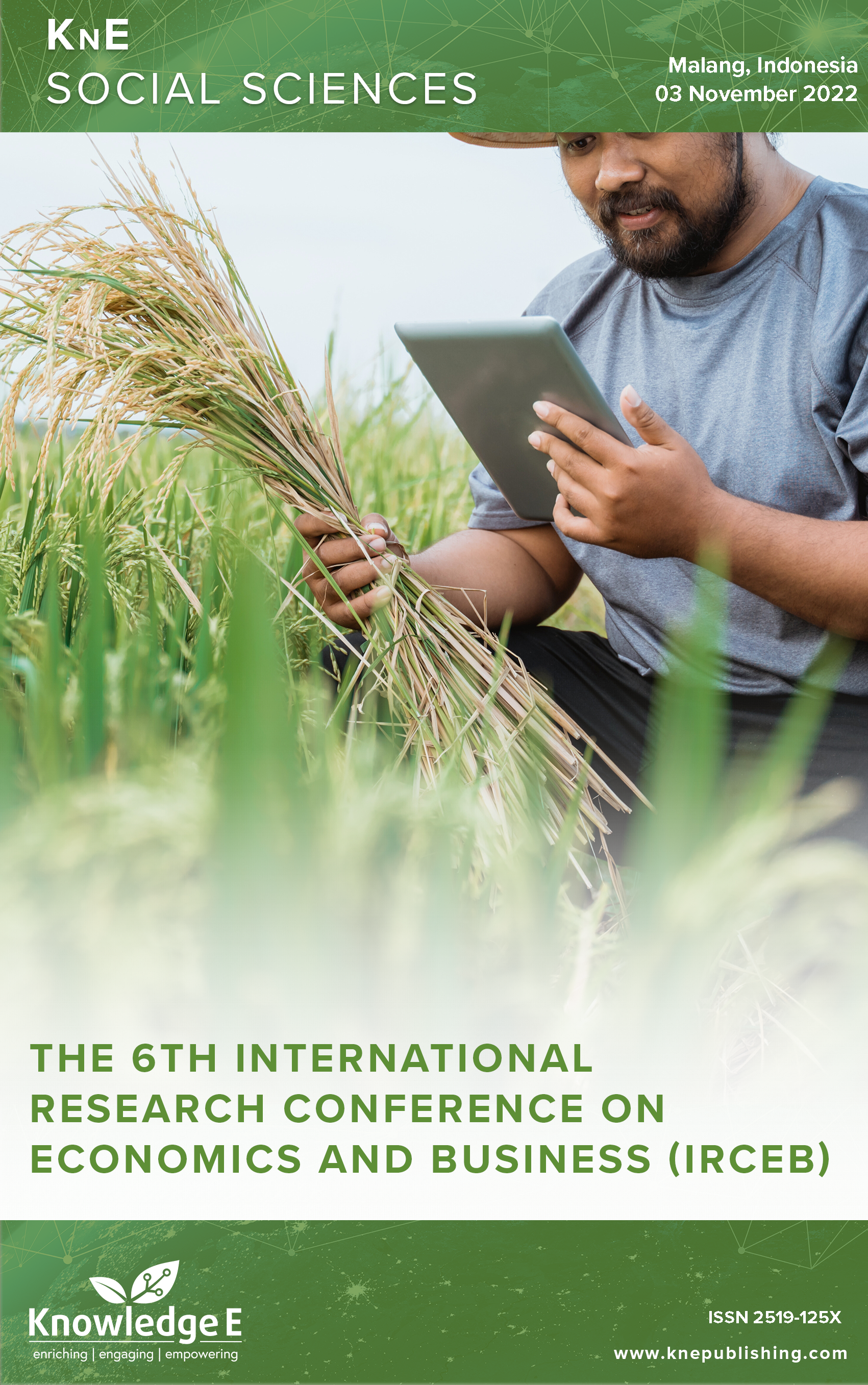The Nexus between Social Presence, Customer Experience and Purchase Intention in Social Commerce Platform Toward Sustainable Digital Economic Development
DOI:
https://doi.org/10.18502/kss.v9i4.15099Abstract
Social media has transformed the digital landscape from connecting people to connecting supply and demand. Many individuals as well as enterprises engage their customers using social media platforms. Transaction through social media could bring influence to digital economic transformation. Producers from various counties could optimize customers participation using their social media accounts. This research aims to explain about the connection among social presence, trust, customer experience and intention to purchase toward social commerce. This study applied quantitative method using partial least squares (PLS-SEM). The data was obtained from 312 respondents, who had conducted online transactions through social media platforms during the last three years. This study showed that social presence and customer experience obtained from selling services had a significant effect on consumer purchase intention. Whereas trust indicators had no effect on consumers’ intention to buy. In maintaining sustainable digital economic development, stakeholders should consider that digital engagement with the public could increase product acceptance and ensure that constructive feedback could be followed up rapidly.
Keywords: social presence, trust, consumers experience, digital economic development
References
David Wesson. Digital culture_ social commerce –The case for redesigning the shopping experience! 2010. https://davidwesson.typepad.com/david_wessons_digital_cul/2010/11/social-commerce-strategythe-case-forredesigning- the-shopping-experience-.html
DeLone WH, McLean ER. Measuring e-commerce success: Applying the DeLone and McLean Information Systems Success Model. Int J Electron Commerce. 2004;9(1):31– 47. DOI: https://doi.org/10.1080/10864415.2004.11044317
Gonçalves Curty R, Zhang P. Website features that gave rise to social commerce: A historical analysis. Electron Commerce Res Appl. 2013;12(4):260–279. DOI: https://doi.org/10.1016/j.elerap.2013.04.001
Gursoy D. A critical review of determinants of information search behavior and utilization of online reviews in decision making process (invited paper for ‘luminaries’ special issue of International Journal of Hospitality Management). International Journal of Hospitality Management. 2019;76(xxxx):53–60. https://doi.org/10.1016/j. ijhm.2018.06.003 DOI: https://doi.org/10.1016/j.ijhm.2018.06.003
Hajli MN. Developing online health communities through digital media. Int J Inf Manage. 2014;34(2):311–314. DOI: https://doi.org/10.1016/j.ijinfomgt.2014.01.006
Hassan M, Iqbal Z, Khanum B. The role of trust and social presence in social commerce purchase intention. Pakistan Journal of Commerce and Social Science. 2018;12(1):111–135.
Johnson-Young EA, ICEK AJZEN. Predicting intentions to breastfeed for three months, six months, and one year using the theory of planned behavior and body satisfaction. Health Commun. 2019 Jun;34(7):789–800. DOI: https://doi.org/10.1080/10410236.2018.1437523
Jarvenpaa SL, Tractinsky N, Vitale M. The meadow limestone or sea chalk storage of the Turloffer See. Consumer trust in an Internet store. 2000;1(1/2):45– 71. http://link.springer.com/10.1023/A:1019104520776 DOI: https://doi.org/10.1023/A:1019104520776
Liang TP, Ho YT, Li YW, Turban E. What drives social commerce: The role of social support and relationship quality. Int J Electron Commerce. 2011;16(2):69–90. DOI: https://doi.org/10.2753/JEC1086-4415160204
Liang TP, Turban E. Introduction to the special issue social commerce: A research framework for social commerce. Int J Electron Commerce. 2011;16(2):5–13. DOI: https://doi.org/10.2753/JEC1086-4415160201
Lu B, Fan W, Zhou M. Social presence, trust, and social commerce purchase intention: an empirical research. Comput Human Behav. 2016;56:225–237. DOI: https://doi.org/10.1016/j.chb.2015.11.057
Palmatier RW, Dant RP, Grewal D, Evans KR. Factors influencing the effectiveness of relationship marketing: A meta-analysis. J Mark. 2006;70(4):136–153. DOI: https://doi.org/10.1509/jmkg.70.4.136
Park H, Kim YK. The role of social network websites in the consumer-brand relationship. J Retailing Consum Serv. 2014;21(4):460–467. DOI: https://doi.org/10.1016/j.jretconser.2014.03.011
Pornwasin A. About 10% of social-media users now shop online. n.d. https://www.nationthailand.com/business/30209666
Saura JR, Reyes-Menendez A, De Matos N, Correia MB, Palos-Sanchez P. Consumer behavior in the digital age. Journal of Spatial and Organizational Dynamic. 2020;8(3):190–196.
Sturiale L, Scuderi A. Evaluation of Social Media Actions for the Agrifood System. Procedia Technology. 2013;8(Haicta):200–208. https://doi.org/10.1016/j.protcy.2013.11.028 DOI: https://doi.org/10.1016/j.protcy.2013.11.028
Vongsraluang N, Bhatiasevi V. The determinants of social commerce system success for SMEs in Thailand. Inf Dev. 2017;33(1):80–96. DOI: https://doi.org/10.1177/0266666916639632
Wang C, Zhang P. The evolution of social commerce: the people, management, technology, and information dimensions. Comm Assoc Inform Syst. 2012;31(1):105– 127. DOI: https://doi.org/10.17705/1CAIS.03105
Wang YS, Liao YW. Assessing eGovernment systems success: A validation of the DeLone and McLean model of information systems success. Gov Inf Q. 2008;25(4):717–733. DOI: https://doi.org/10.1016/j.giq.2007.06.002
Yahia IB, Al-Neama N, Kerbache L. Investigating the drivers for social commerce in social media platforms: Importance of trust, social support and the platform perceived usage. Journal of Retailing and Consumer Services. 2018;41(October 2017):11–19. https://doi.org/10.1016/j.jretconser.2017.10.021 DOI: https://doi.org/10.1016/j.jretconser.2017.10.021
Zhang KZ, Benyoucef M, Zhao SJ. Building brand loyalty in social commerce: The case of brand microblogs. Electron Commerce Res Appl. 2016;15:14–25. DOI: https://doi.org/10.1016/j.elerap.2015.12.001
Zhu DH, Sun H, Chang YP. Effect of social support on customer satisfaction and citizenship behavior in online brand communities: The moderating role of support source. J Retailing Consum Serv. 2016;31:287–293. DOI: https://doi.org/10.1016/j.jretconser.2016.04.013

